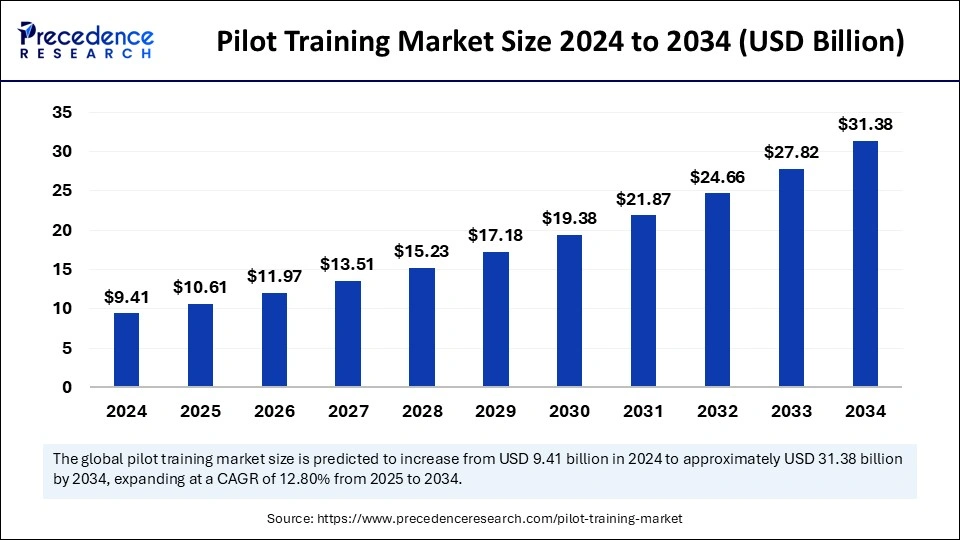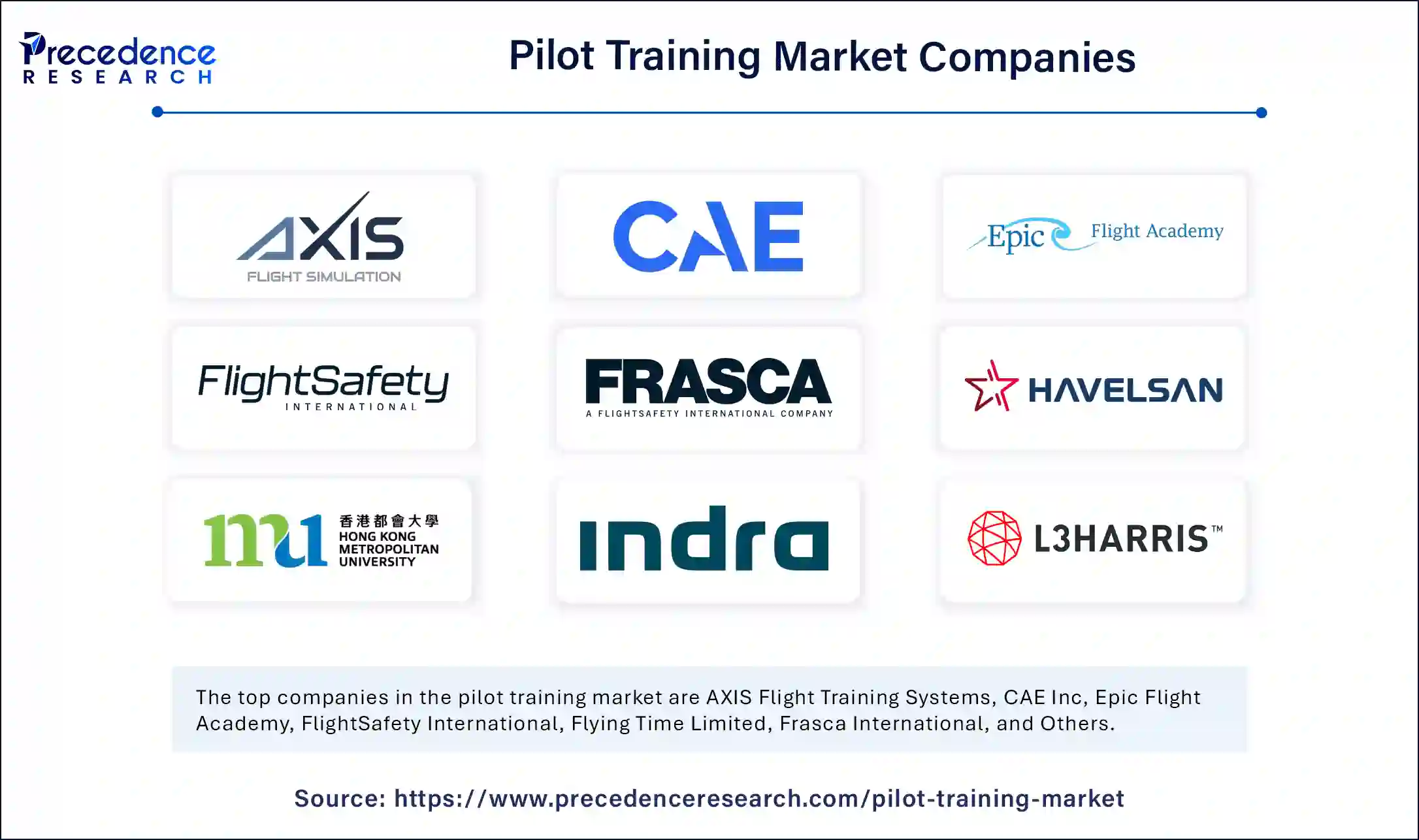March 2025
The global pilot training market size is calculated at USD 10.61 billion in 2025 and is forecasted to reach around USD 31.38 billion by 2034, accelerating at a CAGR of 12.80% from 2025 to 2034. The market sizing and forecasts are revenue-based (USD Million/Billion), with 2024 as the base year.
The global pilot training market size accounted for USD 9.41 billion in 2024 and is predicted to increase from USD 10.61 billion in 2025 to approximately USD 31.38 billion by 2034, expanding at a CAGR of 12.80% from 2025 to 2034. The pilot training market is critical segment within the aviation industry, focusing on developing skilled pilots meet the growing demand for commercial, military, and cargo aviation. As global air traffic increases and new-generation aircraft are introduced, the need for comprehensive and advanced pilot training programs has intensified.

Artificial intelligence is playing a transformative role in revolutionizing the pilot training market. AI-powered systems significantly enhance the precision and realism of flight simulators, allowing trainee pilots to experience wide range of complex flight scenarios in a controlled, risk-free, and cost-effective environment. These intelligence systems can replicate real-world conditions, including adverse weather, systems failures, and emergency situations, which prepares pilots more comprehensively for operational challenges.
Moreover, AI facilitates the personalization of pilot training by delivering customized learning paths tailored to each trainee’s performance and dynamically adjust the training modules, ensuring efficient skill development and mastery of complex maneuvers. This approach accelerates learning outcomes and enhance competency levels.
Furthermore, advancements in haptic feedback within virtual reality environments have added a tactile dimension to pilot training, enabling trainees to feel cockpit controls, which greatly improves muscle memory and reduces the time needed for transition to live flight training.
The global pilot training market is witnessing significant growth due to the increasing demand For commercial pilots driven by the expansion of the aviation industry, rising air passenger traffic, and the need to replace an aging pilot workforce. Technological advancements,including the integration of artificial intelligence (AI), virtual reality and augmented reality are revolutionizing training methods, offering cost-effective, immersive, and efficient solutions. The focus on safety, competency-based training, and regulatory mandates by aviation Authorities such as the FAA and EASA further propel the need of high-quality pilot training
Programs.
| Top 5 countries | Recent Advancements | Aim/Focus |
| United States | Simultaneous technologies and Integrated pilot raising solutions | The aim here is to offer both Commercial and military Programs. |
| China | Advanced flight stimulators and comprehensive pilot training. | Training programs for fixed wing And rotary aircraft . |
| Japan | State of art stimulator and a Global network of training Centers |
Providing training for commercial And business aviation pilot |
| Germany | Aircraft, integrating latest Generation simulators and flight Instructions | To offer pilot training for Airbus and aircraft |
| United Kingdom | Delivers comprehensive pilot Training services. | Addressing the growing demand |
| Report Coverage | Details |
| Market Size by 2034 | USD 31.38 Billion |
| Market Size in 2025 | USD 10.61Billion |
| Market Size in 2024 | USD 9.41 Billion |
| Market Growth Rate from 2025 to 2034 | CAGR of 12.80% |
| Dominated Region | North America |
| Fastest Growing Market | Asia Pacific |
| Base Year | 2024 |
| Forecast Period | 2025 to 2034 |
| Segments Covered | Type, Application, Component, System, and Regions |
| Regions Covered | North America, Europe, Asia-Pacific, Latin America, and Middle East & Africa |
Growth in Air Travel Demand
The rapid increase in global air travel is one of the primary drivers of the pilot training market. Rising disposable incomes, especially in emerging economies, coupled with the expansion of low-cost carriers, have made air travel more accessible than ever before. According to the International Air Transport Association (IATA), global passenger numbers are expected to reach 4.7 billion in 2025, surpassing pre-pandemic levels. This surge in air travel has intensified the demand for skilled pilots, prompting airlines and training academies to invest heavily in pilot development programs. Additionally, the growth of cargo and logistics air transport has added further pressure on pilot availability, boosting the need for comprehensive and efficient training solutions.
High Costs of Pilot Training
Despite the growing demand, one of the major barriers to market expansion is the high cost associated with pilot training. The average cost of obtaining a commercial pilot license (CPL) ranges from $70,000 to $150,000, making it a significant financial burden for aspiring pilots. The costs are driven by expensive flight hours, simulator training, and regulatory certifications.
This financial barrier often limits the pool of potential candidates, especially in developing regions where access to funding and financial aid is limited. Furthermore, maintenance costs for advanced flight simulators and the integration of cutting-edge technologies like AI and VR further increase the overall expenditure for training institutions.
Expansion in Aviation Infrastructure
A significant opportunity lies in the ongoing expansion of aviation infrastructure worldwide. As governments and private investors channel funds into building new airports and upgrading existing ones, the need for a larger, well-trained pilot workforce becomes critical. Notably, Asia-Pacific regions, particularly India and China, are investing heavily in expanding airport networks and air traffic management systems. For example, India's government plans to develop 100 new airports by 2030 under the UDAN scheme, fostering regional connectivity. This infrastructural boom is expected to fuel demand for pilots and subsequently pilot training programs.
In 2024, the fixed-wing segment held the largest market share due to the high demand for commercial airline pilots and the extensive growth of the passenger aviation sector. Airlines worldwide are expanding their fleets with fixed-wing aircraft to meet surging air travel demand. According to Boeing’s 2025 Pilot and Technician Outlook, over 500,000 new fixed-wing pilots will be needed by 2040, with the Asia-Pacific region leading in demand.
On the other hand, the rotary-wing segment is experiencing significant growth, driven by increased demand in sectors such as emergency medical services (EMS), offshore oil and gas, military, and tourism. Recent updates include CAE’s launch of its Helicopter Flight Training Centre in Oslo in early 2025, catering to the increasing need for rotary-wing pilots in Europe’s offshore energy sector.
The civil segment continues to dominate the market, propelled by the booming passenger travel industry and the cargo sector’s rising needs. Airlines are investing heavily in pilot training to address the shortage of qualified professionals. As of March 2025, IndiGo Airlines (India) has partnered with CAE to launch a dedicated cadet pilot program, aimed at training 2,000 commercial pilots by 2030.
However, military segment is growing due to increasing defense budgets and modernization initiatives worldwide. Countries like the U.S., China, and India are upgrading their air forces, driving demand for sophisticated pilot training programs. Notably, L3Harris announced its next-gen military simulation system in February 2025, which uses AI for enhanced mission rehearsal.
Simulator systems held the largest share in 2024 due to their cost-efficiency and ability to replicate complex flight scenarios without risk. CAE’s 7000XR Series simulators remain industry benchmarks, with a new model released in 2025, featuring integrated VR and AI to enhance realism and decision-making under stress.
Furthermore, the training services segment is rapidly expanding, especially in developing regions with a shortage of local flight schools. Alpha Aviation Academy, based in the UAE, recently expanded its global footprint by opening new pilot training services in the Philippines and India in March 2025, focusing on customized training programs for regional carriers.
Full flight simulators segment dominated the pilot training market in 2024, offering comprehensive training in controlled environments that meet regulatory requirements. In early 2025, Thales Group unveiled its Reality H Full Flight Simulator, incorporating AI-driven scenario generation for realistic responses and improved pilot competency.
On the other, the flight training devices are gaining traction due to lower costs and regulatory flexibility. They are often used for early-stage pilot training or specific competency refreshers. SimCom Aviation Training expanded its Level 5 FTD network in March 2025, making training more accessible for regional airlines and private pilot programs.
North America Pilot Training Market Trends:
North America remains the dominant region in the global pilot training market. This is primarily due to its highly developed aviation industry, a vast network of training institutions, and stringent regulatory frameworks from the Federal Aviation Administration (FAA). The region has seen a constant demand for both commercial and military pilots, driven by the expansion of passenger air travel, cargo services, and defense aviation programs. Canada is one of the largest providers of pilot training solutions globally, CAE operates multiple training centers across North America, offering state-of-the-art Full Flight Simulators (FFS) and AI-powered learning management systems.
U.S. Pilot Training Market Trends
In March 2025, CAE announced a $1.2 billion investment into expanding its North American training network, including five new centers in the U.S. and Canada focusing on next-generation simulators. L3Harris opened a Military Simulation and Training Center in Texas in early 2025, enhancing its offerings for military jet and helicopter pilot programs.
Asia Pacific Pilot Training Market Trends:
Asia Pacific is the fastest-growing region in the pilot training market. The expansion of aviation infrastructure, increasing passenger traffic, and the rise of low-cost carriers across countries such as China, India, Indonesia, and Vietnam are driving demand. Additionally, regional governments are investing in developing indigenous training programs to reduce dependence on international training schools. In March 2025, India’s Indira Gandhi Institute launched an AI-driven simulator center in Mumbai, designed to meet the increasing demand for narrow-body aircraft pilots.
Pilot training market in Philippines and India
Europe Pilot Training Market Trends:
Europe is emerging as a significant growth region in the pilot training market. The increasing demand for commercial pilots, driven by the expansion of low-cost carriers and regional airlines, is boosting the market. Additionally, government investments in modernizing military aviation and defense training systems further contribute to this growth.
Pilot training market in Spain and France

By Type
By Application
By Component
By System
By Geography
For inquiries regarding discounts, bulk purchases, or customization requests, please contact us at sales@precedenceresearch.com
No cookie-cutter, only authentic analysis – take the 1st step to become a Precedence Research client
March 2025